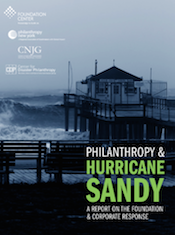Site Search
- resource provided by the Forum Network Knowledgebase.
Search Tip: Search with " " to find exact matches.

Community foundations are beginning to deepen and shift how they work, adopting an anchor mission that seeks to fully deploy all resources to build community wealth. Moving into territory relatively uncharted for community foundations, they are taking up impact investing and economic development — some in advanced ways, others with small steps. This report offers an overview of how 30 representative community foundations — including The Seattle Foundation, the Vermont Community Foundation, and the Greater Cincinnati Foundation — are working toward adopting this new anchor mission.
This Democracy Collaborative report was written by Marjorie Kelly, Senior Fellow and Director of Special Projects and Violeta Duncan, Community Development Associate.
Nonprofit Finance Fund's Annual Survey chronicles the challenges facing the nonprofit sector and calls out some of the targeted investments we can start to agree on as a society to salvage the investment we have collectively made in our social infrastructure. We believe that a coordinated intervention now will not only better prepare us for inevitable future economic crises; it can lead to a happier, healthier community for us all.
A corporate funder asked our corporate funder listserve about how the corporate foundation is funded either through an endowment or through periodic transfers, or though a share of the profits? This document is a compilation of the responses on the listserve.
"Co-Creation" is a case study about the Connecticut Early Childhood Funder Collaborative, a project of the Connecticut Council for Philanthropy. The case study, written by Patricia Bowie, examines co-creation, an emerging systems change collaboration model which grew out of a funder-and-state partnership. This unique partnership led to the creation by executive order of a new and independent Office of Early Childhood, which was formally approved by the Connecticut State Legislature in 2013. The companion piece, "Taking on New Roles to Address 21st Century Problems," looks at co-creation from the perspective of a regional association of grantmakers.
The Connecticut Early Childhood Funder Collaborative comprises 14 funders from around the state who bring many years of experience in supporting and operating programs that serve the needs of children and families.
What comes after “strategic...?” If you said, “planning,” you’re not alone. And for many leaders of community foundations, especially small ones who don’t have the time or money for a big process, anxiety is the feeling that follows. If that’s the case, this guide is for you.
It invites you to test-drive some activities to bring your current program, operations and community leadership strategies into focus before you decide whether to create a plan or not. It helps you discover ongoing strategic practices and decide whether to keep them or not. If you already have done a strategic plan, and it is languishing on a shelf, this guide will help you refresh it.
PART A: Good Strategy Takes Practice (Not Just Planning)
PART B: Do Your Discovery
PART C: Jumpstart Your Strategy Narrative
PART D: Bring It Together
Looking To What’s Next
This weekly funder briefing webinar series welcomed New Jersey-based grantmakers along with national funders and provided an opportunity for grantmakers to hear from a wide range of nonprofit experts. This series started on March 13, 2025, less than a month after the first executive order was issued and continued through April 24, 2025. The recordings of each are below.
Immigration Webinar
Health Webinar
Environment Webinar
Education Webinar
Housing Webinar
Media & Journalism Webinar
Arts Webinar
This weekly conference call series welcomed New Jersey-based grantmakers along with national funders and provided an opportunity for grantmakers to hear from a wide range of experts in the field of disaster philanthropy. This series started on November 5, 2012, one week after Sandy struck New Jersey, and continued through March 25, 2013. The audio files of each recording are listed below.
Update from The President's Hurricane Sandy Rebuilding Task Force (3/25/13)
Environmental Justice Issues (3/18/13)
Update from the Governor's Office of Recovery and Rebuilding & Universal Design (3/11/13)
Governor & Mrs. Christie's Hurricane Sandy NJ Relief Fund & Report on Ocean/Monmouth Tour (3/4/13)
Christopher Kaufman Ilstrup, Vermont Community Foundation (2/25/13)
NJ Recovery Fund and Post Sandy Environmental Issues and Challenges (2/11/13)
Housing Issues Related to Natural Disasters and Post Hurricane Sandy (2/4/13)
FEMA's Long Term Recovery and Capacity Building Team (1/28/13)
Reports from NJ's Long Term Recovery Groups and Environmental Leaders Meeting (1/14/13)
Stewart Sarkozy-Banoczy, Director of the Office of International & Philanthropic Innovation (1/7/13)
Dr. April Naturale - Mental Health Issues Resulting from Disasters (12/17/12)
Peter Kasabach, Executive Director of New Jersey Future (12/10/12)
Byron Mason of the Federal Department of Health and Human Services (12/3/12)
John Grady Davies, President of Baton Rouge Area Foundation (11/26/12)
Cathy McCann, President of NJ Voluntary Organizations Active in Disasters (11/19/12)
Jera Stribling, Executive Director of Bruno Foundation and FEMA (11/12/12)
FEMA - Long Term Recovery Office (11/5/12)
This weekly conference call series welcomed New Jersey-based grantmakers along with national funders and provided an opportunity for grantmakers to hear from a wide range of experts in the field of disaster philanthropy. This series started on September 9, 2013 and concluded on November 4, 2013. The audio files of each recording are listed below.
What Philanthropy Has Learned One Year After Sandy (11/4/13)
Mental Health Needs in Aftermath of Sandy (10/28/13)
Post-Sandy Housing, Planning & Resiliency Initiatives (10/21/13)
Post-Sandy Environmental Issues and Climate Change Effects on NJ (10/7/13)
NJ Dept of Community Affairs Sandy Recovery Programs with Stacy Bonnaffons (9/30/13)
Long Term Recovery Issues and Strategies (9/23/13)
Update on Statewide Progress of Long Term Recovery (9/16/13)
With the Group Chairs from Bergen, Cumberland & Monmouth Counties along with Cathy McCann, President of NJVOAD
Review of Federal Task Force Recommendations with NJ Director Michael Passante (9/9/13)
